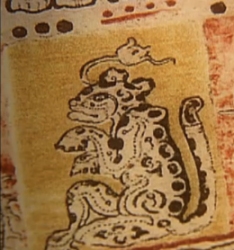
By Samita Sarkar
Recently, I watched an informative PBS documentary about the history of the Maya language called Cracking the Maya Code (watch it online here). Much like the other indigenous civilizations of the Americas that encountered Europeans hundreds of years ago, the Maya experienced cultural and linguistic oppression at the hands of Spanish colonizers. Under the sixteenth-century Spanish inquisition, the Maya were tortured or killed for engaging in “superstitious” behaviour, such as writing in their language or worshipping their gods. A zealous friar, Diego de Landa, made it his mission to destroy Maya hieroglyphs, seeing them as tools of the devil. He sanctioned the mass burning of hundreds to thousands of Maya books—the exact number will never be known.
To us editors, the act of burning countless ancient texts seems worse than blasphemy, but to the mercurial Friar de Landa, it was a powerful method of oppression. And it worked—by the eighteenth century, there was no one left who could read or write Maya.
Only a handful of Maya books survived, and they resurfaced in the late 1880s. Linguists tried for decades to crack the Maya code using only a few books and glyphs carved into ancient Maya pyramids. Written Maya had a script of 800 symbols, and it was taken for granted that these were logographs and not phonetic letters.
J. Eric Thompson, an Englishman who lived among the Maya and studied their language, argued that time and astronomy were the focus of their culture, leading to a view of the Maya as a peaceful civilization of stargazers. He concluded that, unlike spoken Maya, written Maya was limited, and beyond dates and astronomical references, there was nothing more to it. His theory was problematic because not only was it inaccurate but it was also an oversimplification of a complex and sophisticated culture, which led to stereotyping the Maya as “noble savages” who didn’t suffer from “European vices” like war and greed.

A Russian linguist named Yuri Knorozov opposed Thompson’s theory. He learned while obtaining his linguistics degree that the first step to analyzing Maya would be counting the letters: A script with 20 to 30 letters was usually alphabetic (like English or Somali), with letters representing sounds. A script with 80 to 100 letters meant the script was syllabic, with letters representing syllables (like Cherokee or Hindi). A script with several hundred letters was logographic, with a symbol for each word (like Chinese). Maya had 800 symbols—too few to have a symbol for each word, but too many for the script to be alphabetic or syllabic. While it was the dominant view, proposed by Eric Thompson, that the Maya used a limited logographic script, Knorozov knew that no script fell completely into one of the three categories. He proposed that the Maya used both word signs and phonetic signs in their script, but Thompson, a vehement anti-communist, discredited him in the West. (This was before the age of the Internet, so it was easier to stop people from making their discoveries known.)
Archaeologist David Stuart, a genius who wrote his first scholarly paper on the Maya at age 12, has been doing much of the Maya decipherment from the late 1980s onward. He discovered that one sign could substitute more than one syllable, entailing that there was more than one way to spell a word. One syllable could even have 15 substitutions, and two signs could join or overlap. The Maya disliked repetition, and the fact that there were many ways to spell a word was part of the art of their system of writing.
As editors, writers, or both, I think we can all appreciate the Maya story. The Cracking the Maya Code documentary shows us, using an excellent example, why it is so important for people to have the opportunity to tell their own story. When the Maya code was cracked, it changed history. Through the eyes of the colonizers, the Maya were uncivilized, human-sacrificing heathens, while according to more recent Western views, they were astrology-obsessed noble savages. Even though one view of the Maya is certainly more sinister than the other, both are misleading and condescending.
The Maya story also illustrates the importance of communication. Knorosov’s contributions went unrecognized in the West for many years because the prevailing figure in archaeology at the time disliked what he had to say. Nowadays, our society is different. We can reach more people in a shorter amount of time with our ideas and our writing. As editors, we can take clients from anywhere in the world. There is no end to the ways that we can help and influence each other.
Although the Maya were treated horribly by the settlers—much like other native groups—the Maya story stands out because, unlike many oral pre-colonial civilizations in the Americas, the Maya were one of few who had a significant written culture. Deciphering their script gave our modern civilization the chance to learn about their ancient one, as they saw it, through their own words. This unique pre-colonial indigenous insight gives archaeologists a more complex view of who the Maya were and how they saw themselves.
With greater knowledge of the past, we can better understand who we are and where we are going. Descendents of the Maya, who still speak the Maya language and practice ancient religious rituals, are now able to take lessons on how to write in the Maya script. Although it is a relief that what was almost lost didn’t manage to slip away, I still can’t help but wonder what was contained in that vast collection of books that de Landa had so callously burned to the ground.
Samita Sarkar is the owner of Blossoms Editing Services. She specializes in editing scientific texts and documents.

One thought on “The importance of language as shown by ancient Maya civilization”